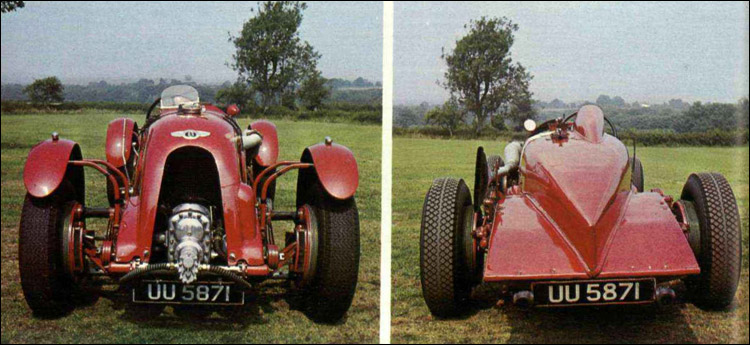Article: Driving the Ex-Birkin Blower-4½ Single-Seater Bentley (Page 5 of 8)
Extract from: Motor Sport, by William Boddy, October 1973
Before the lubrication system was altered to convert the engine to dry-sump, the Roots-type Villiers had been further modified. The electron centre casing was replaced with an aluminium centre casing and this together with oversize rotors increased the maximum boost to 12 lb./sq. in. The side-draught SUs were replaced by two enormous horizontal down-draught ones. These 62 mm. carburetters passed a gallon of fuel every 59 sec., whereas previously the flow at full throttle had been a gallon every 73 sec. This gave a consumption of approx. 2 m.p.g. at racing speeds, on a 40/30/30 methanol-benzole-petrol mixture. In conjunction with the new lubrication system a small pack-type oil-cooler was located in the oil-line close to the n/s rear front spring hanger. The downdraught carburetters were used for the successful 1932 lap-record run, and the drysump lubrication was ready for that year's BE Trophy Race.


The Bentley was going very well indeed by 1932. In practice four days before the Easter Brooklands Meeting Birkin achieved his goal, breaking Don's record by 0.2 sec., setting the lap-record to 137.96 m.p.h. This lent interest to the subsequent race appearances. Birkin was second in the Norfolk Lightning Short Handicap (in which the Bentley and Cobb's Delage had started together from scratch) lapping at 134.24 m.p.h. Although slower in the "Long" race, he won from his old rival, the Delage, at 122.08 m.p.h. in spite of a nasty down-banking skid. In his first race Birkin had apparently caught his foot on the spare oil tank, which spoilt his getaway, for normally the s.s. lap was done at nearly 108 m.p.h.
In the BRDC British Empire Trophy Race, run in a series of heats and a final over the outer-circuit, a splendid coming together of the fastest track cars (which surprisingly is ignored in "A Racing History of the Bentley", although Dunfee's Speed Six also took part in it), Birkin got to within second place behind Eyston's 8-litre Panhard Levassor in his heat when a front tyre went to pieces. The pit-stop was a long one but the Bentley eventually finished 4th, at 116.95 m.p.h. Birkin made a bid for victory in the Final but after passing the Panhard and averaging over 124 m.p.h. for 50 miles he came in for water and later retired with a cracked block, ominous white smoke streaming from the exhaust pipe. However, he was OM again at the Whitsun meeting, with a standard-dimension cylinder block meeting Cobb's Delage again in the Nottingham Senior Short Handicap. The problem was now passing the Delage, which had to go high on the banking to get by the fast small cars. The Bentley finished two feet behind it, in 4th place, after lapping 8½ m.p.h. faster than Cobb once it got into its stride. The task in the Gold Star race was hopeless and Birkin came in.
At the 1932 Guy's Gala Meeting the Bentley won the Long Handicap under gusty conditions at 124.33 m.p.h. but a tyre tread came off the o/s rear tyre during the Duke of York's race, striking Birkin on the shoulder, but not before he had equalled his lap-record. At the BARC August Meeting Cobb and Birkin raced together in a 100 sovs. Match Race over three laps. The Bentley accelerated more slowly than its older but much bigger-engined rival and was 3.8 sec. behind after the first lap. It cut this down to 1.4 sec. next time round and at the Fork on the last lap was within 1/5 of a sec. of the Delage. Birkin recalls that "As we came off the Members banking I felt the Bentley, as it were, hang above it (the Dalage) for an instant and then shoot ahead". He won the duel by 4/5 of a sec., and did that last lap in a strong wind at 137.58 m.p.h. During this hectic race the streamlined head-rest came off the body and flew high in the air. Later that afternoon he was second in the Hereford Lightning Long Handicap 3/5 of a. sec. behind Shuttleworth's Bugatti, lapping at 136.45 m.p.h., from scratch, of course.
Continued on next page
